Accounting Research Report: Stock Market Movements and Investor Impact
VerifiedAdded on 2022/10/02
|17
|4486
|391
Report
AI Summary
This report, an accounting research assignment for the Melbourne Institute of Technology's MA619 course, examines stock market dynamics in India. It begins by discussing the emergence of the stock market within the context of economic liberalization and globalization, highlighting its role in mobilizing resources and influencing economic growth. The report delves into the challenges of predicting stock market movements, citing various influencing factors such as macroeconomic variables, political events, and investor psychology. It presents historical data on the BSE Sensex and NSE-Nifty indices, analyzing pre- and post-global financial crisis periods to illustrate market trends. Furthermore, the report explores the relationship between stock market performance and the broader economy, while also examining the impact of key events on the Indian stock exchange and investor behavior. The paper also discusses the future prospects of the capital market, including market segmentation and integration. Overall, the report aims to provide investors with insights to aid in making informed investment decisions.
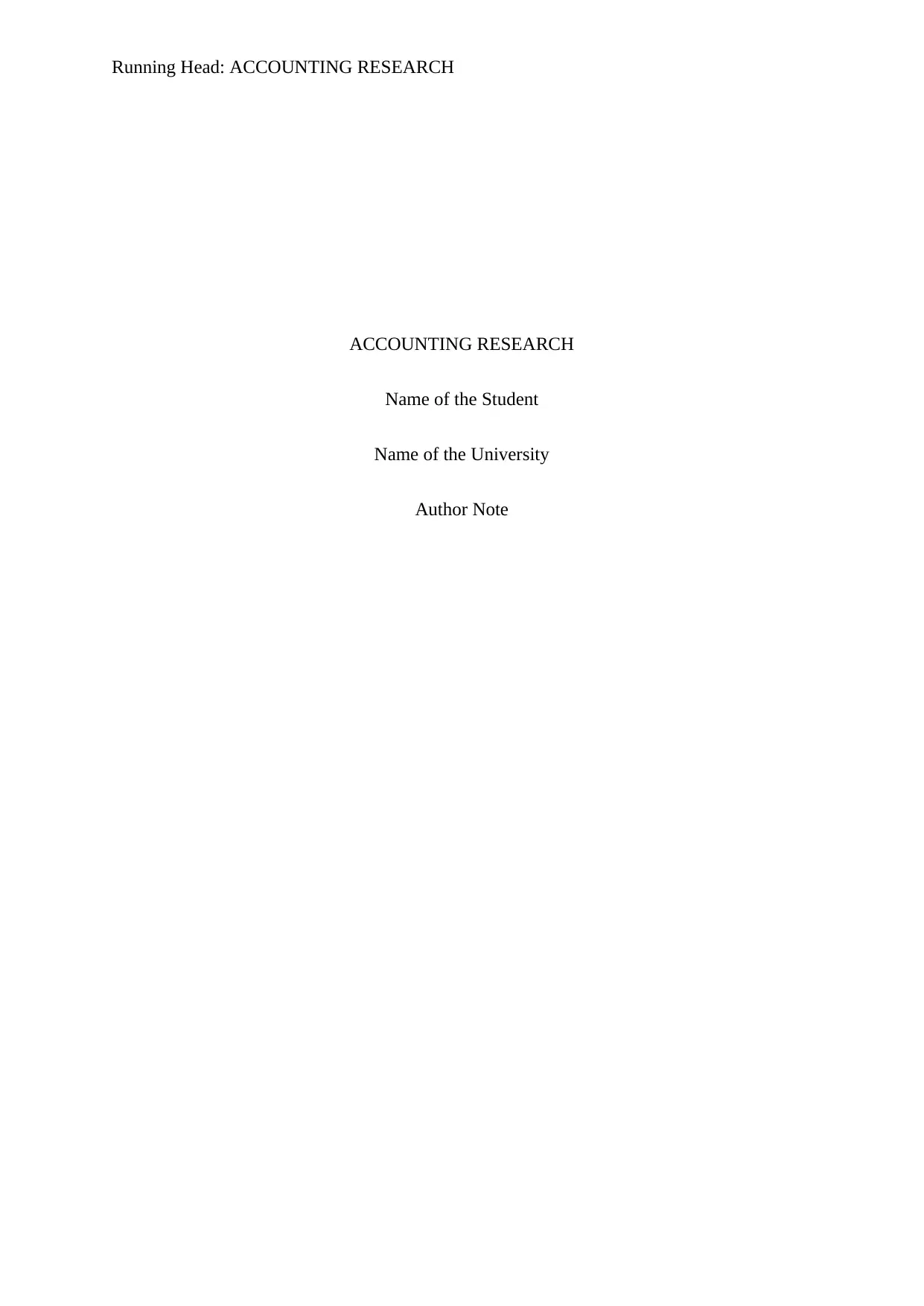
Running Head: ACCOUNTING RESEARCH
ACCOUNTING RESEARCH
Name of the Student
Name of the University
Author Note
ACCOUNTING RESEARCH
Name of the Student
Name of the University
Author Note
Paraphrase This Document
Need a fresh take? Get an instant paraphrase of this document with our AI Paraphraser
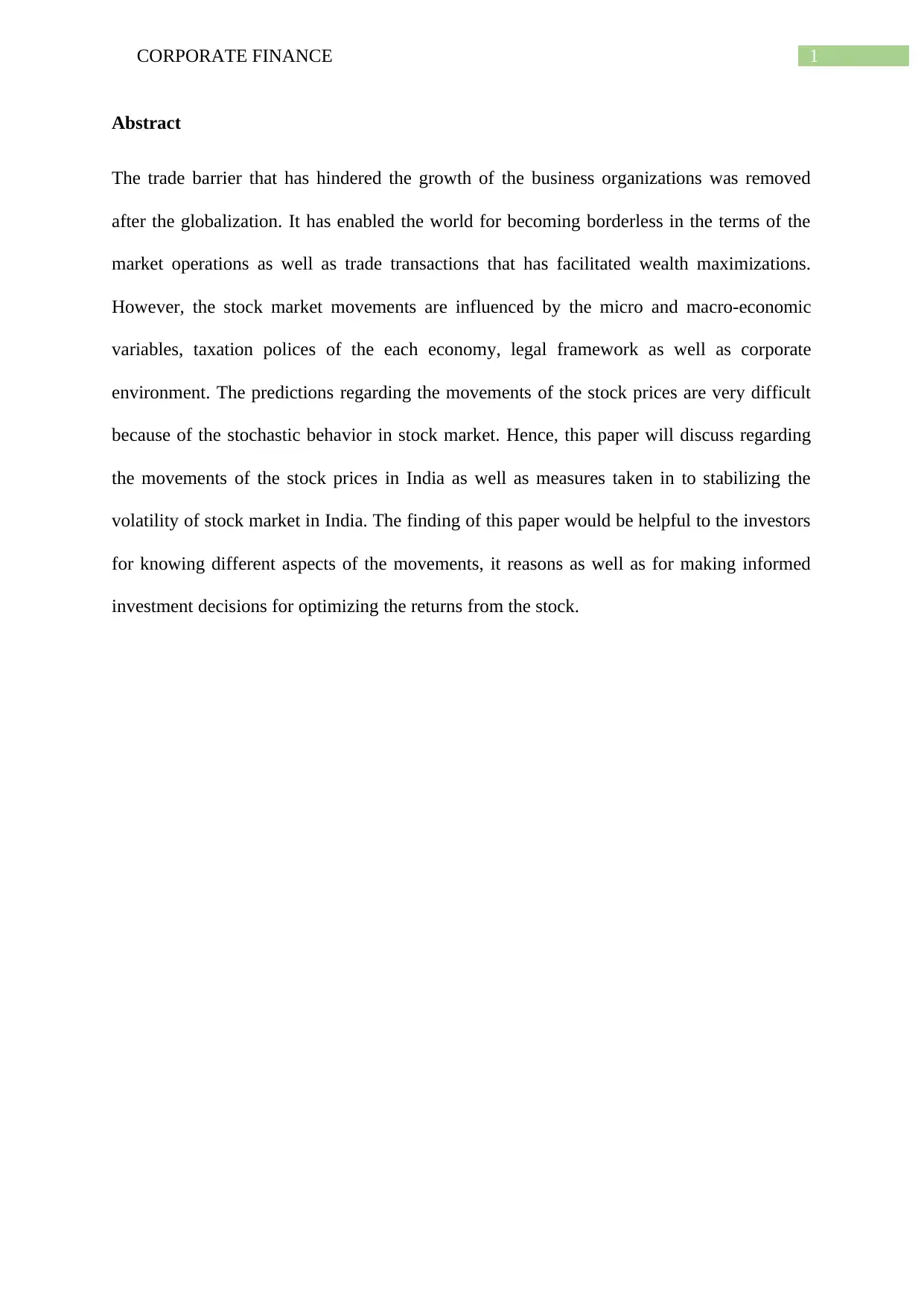
1CORPORATE FINANCE
Abstract
The trade barrier that has hindered the growth of the business organizations was removed
after the globalization. It has enabled the world for becoming borderless in the terms of the
market operations as well as trade transactions that has facilitated wealth maximizations.
However, the stock market movements are influenced by the micro and macro-economic
variables, taxation polices of the each economy, legal framework as well as corporate
environment. The predictions regarding the movements of the stock prices are very difficult
because of the stochastic behavior in stock market. Hence, this paper will discuss regarding
the movements of the stock prices in India as well as measures taken in to stabilizing the
volatility of stock market in India. The finding of this paper would be helpful to the investors
for knowing different aspects of the movements, it reasons as well as for making informed
investment decisions for optimizing the returns from the stock.
Abstract
The trade barrier that has hindered the growth of the business organizations was removed
after the globalization. It has enabled the world for becoming borderless in the terms of the
market operations as well as trade transactions that has facilitated wealth maximizations.
However, the stock market movements are influenced by the micro and macro-economic
variables, taxation polices of the each economy, legal framework as well as corporate
environment. The predictions regarding the movements of the stock prices are very difficult
because of the stochastic behavior in stock market. Hence, this paper will discuss regarding
the movements of the stock prices in India as well as measures taken in to stabilizing the
volatility of stock market in India. The finding of this paper would be helpful to the investors
for knowing different aspects of the movements, it reasons as well as for making informed
investment decisions for optimizing the returns from the stock.

2CORPORATE FINANCE
Table of Contents
Literature Review.......................................................................................................................3
Reference..................................................................................................................................14
Table of Contents
Literature Review.......................................................................................................................3
Reference..................................................................................................................................14
⊘ This is a preview!⊘
Do you want full access?
Subscribe today to unlock all pages.

Trusted by 1+ million students worldwide
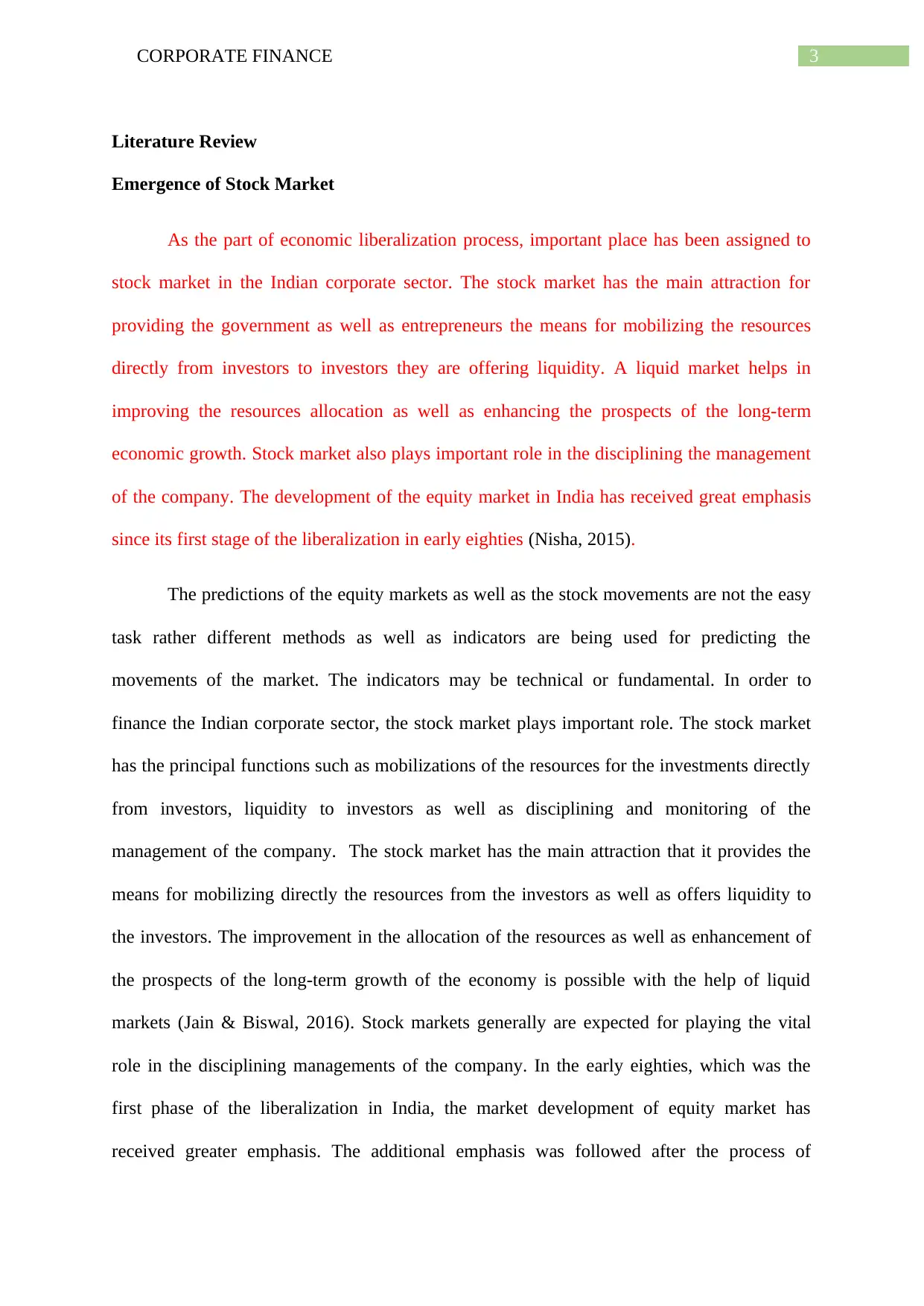
3CORPORATE FINANCE
Literature Review
Emergence of Stock Market
As the part of economic liberalization process, important place has been assigned to
stock market in the Indian corporate sector. The stock market has the main attraction for
providing the government as well as entrepreneurs the means for mobilizing the resources
directly from investors to investors they are offering liquidity. A liquid market helps in
improving the resources allocation as well as enhancing the prospects of the long-term
economic growth. Stock market also plays important role in the disciplining the management
of the company. The development of the equity market in India has received great emphasis
since its first stage of the liberalization in early eighties (Nisha, 2015).
The predictions of the equity markets as well as the stock movements are not the easy
task rather different methods as well as indicators are being used for predicting the
movements of the market. The indicators may be technical or fundamental. In order to
finance the Indian corporate sector, the stock market plays important role. The stock market
has the principal functions such as mobilizations of the resources for the investments directly
from investors, liquidity to investors as well as disciplining and monitoring of the
management of the company. The stock market has the main attraction that it provides the
means for mobilizing directly the resources from the investors as well as offers liquidity to
the investors. The improvement in the allocation of the resources as well as enhancement of
the prospects of the long-term growth of the economy is possible with the help of liquid
markets (Jain & Biswal, 2016). Stock markets generally are expected for playing the vital
role in the disciplining managements of the company. In the early eighties, which was the
first phase of the liberalization in India, the market development of equity market has
received greater emphasis. The additional emphasis was followed after the process of
Literature Review
Emergence of Stock Market
As the part of economic liberalization process, important place has been assigned to
stock market in the Indian corporate sector. The stock market has the main attraction for
providing the government as well as entrepreneurs the means for mobilizing the resources
directly from investors to investors they are offering liquidity. A liquid market helps in
improving the resources allocation as well as enhancing the prospects of the long-term
economic growth. Stock market also plays important role in the disciplining the management
of the company. The development of the equity market in India has received great emphasis
since its first stage of the liberalization in early eighties (Nisha, 2015).
The predictions of the equity markets as well as the stock movements are not the easy
task rather different methods as well as indicators are being used for predicting the
movements of the market. The indicators may be technical or fundamental. In order to
finance the Indian corporate sector, the stock market plays important role. The stock market
has the principal functions such as mobilizations of the resources for the investments directly
from investors, liquidity to investors as well as disciplining and monitoring of the
management of the company. The stock market has the main attraction that it provides the
means for mobilizing directly the resources from the investors as well as offers liquidity to
the investors. The improvement in the allocation of the resources as well as enhancement of
the prospects of the long-term growth of the economy is possible with the help of liquid
markets (Jain & Biswal, 2016). Stock markets generally are expected for playing the vital
role in the disciplining managements of the company. In the early eighties, which was the
first phase of the liberalization in India, the market development of equity market has
received greater emphasis. The additional emphasis was followed after the process of
Paraphrase This Document
Need a fresh take? Get an instant paraphrase of this document with our AI Paraphraser
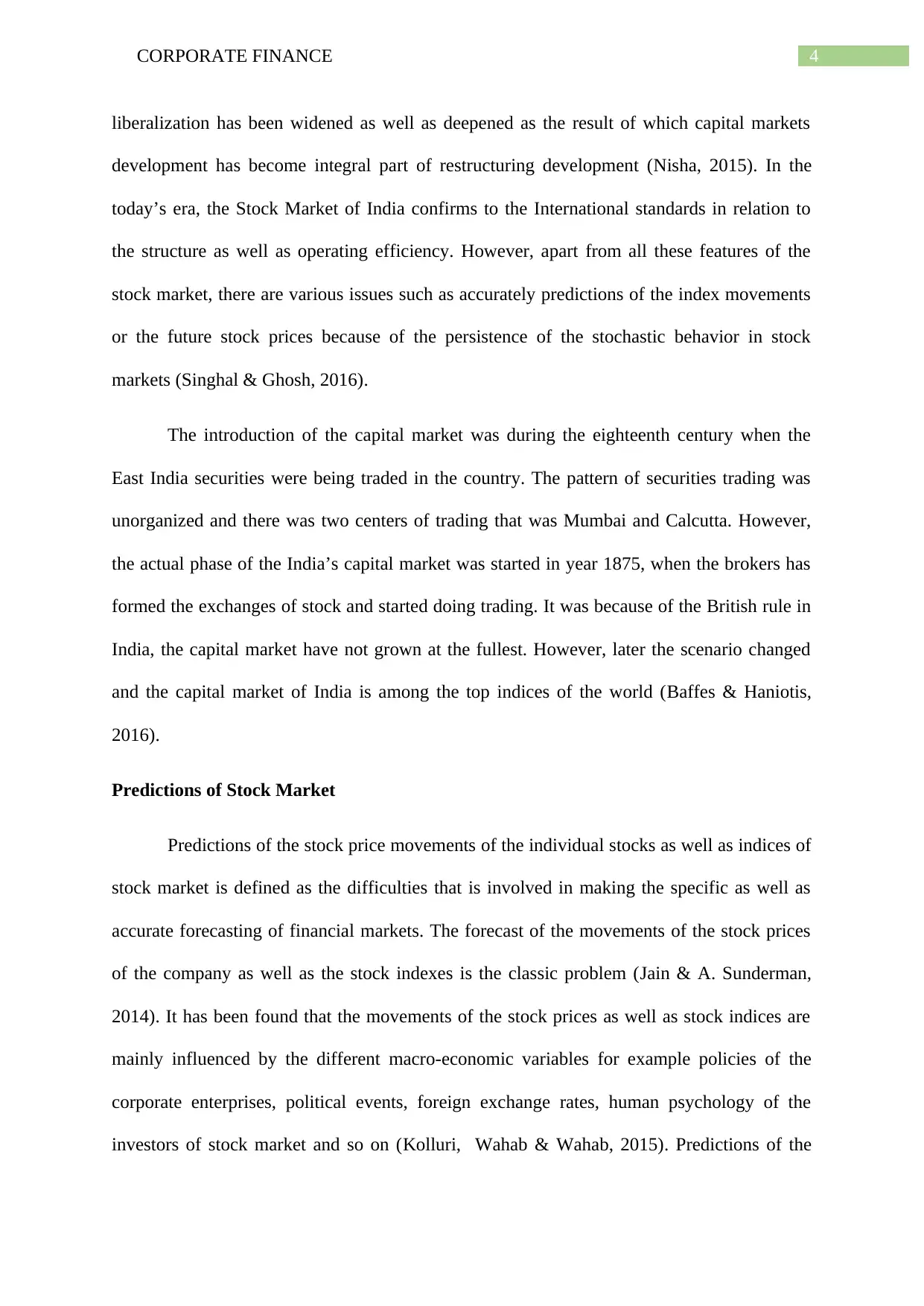
4CORPORATE FINANCE
liberalization has been widened as well as deepened as the result of which capital markets
development has become integral part of restructuring development (Nisha, 2015). In the
today’s era, the Stock Market of India confirms to the International standards in relation to
the structure as well as operating efficiency. However, apart from all these features of the
stock market, there are various issues such as accurately predictions of the index movements
or the future stock prices because of the persistence of the stochastic behavior in stock
markets (Singhal & Ghosh, 2016).
The introduction of the capital market was during the eighteenth century when the
East India securities were being traded in the country. The pattern of securities trading was
unorganized and there was two centers of trading that was Mumbai and Calcutta. However,
the actual phase of the India’s capital market was started in year 1875, when the brokers has
formed the exchanges of stock and started doing trading. It was because of the British rule in
India, the capital market have not grown at the fullest. However, later the scenario changed
and the capital market of India is among the top indices of the world (Baffes & Haniotis,
2016).
Predictions of Stock Market
Predictions of the stock price movements of the individual stocks as well as indices of
stock market is defined as the difficulties that is involved in making the specific as well as
accurate forecasting of financial markets. The forecast of the movements of the stock prices
of the company as well as the stock indexes is the classic problem (Jain & A. Sunderman,
2014). It has been found that the movements of the stock prices as well as stock indices are
mainly influenced by the different macro-economic variables for example policies of the
corporate enterprises, political events, foreign exchange rates, human psychology of the
investors of stock market and so on (Kolluri, Wahab & Wahab, 2015). Predictions of the
liberalization has been widened as well as deepened as the result of which capital markets
development has become integral part of restructuring development (Nisha, 2015). In the
today’s era, the Stock Market of India confirms to the International standards in relation to
the structure as well as operating efficiency. However, apart from all these features of the
stock market, there are various issues such as accurately predictions of the index movements
or the future stock prices because of the persistence of the stochastic behavior in stock
markets (Singhal & Ghosh, 2016).
The introduction of the capital market was during the eighteenth century when the
East India securities were being traded in the country. The pattern of securities trading was
unorganized and there was two centers of trading that was Mumbai and Calcutta. However,
the actual phase of the India’s capital market was started in year 1875, when the brokers has
formed the exchanges of stock and started doing trading. It was because of the British rule in
India, the capital market have not grown at the fullest. However, later the scenario changed
and the capital market of India is among the top indices of the world (Baffes & Haniotis,
2016).
Predictions of Stock Market
Predictions of the stock price movements of the individual stocks as well as indices of
stock market is defined as the difficulties that is involved in making the specific as well as
accurate forecasting of financial markets. The forecast of the movements of the stock prices
of the company as well as the stock indexes is the classic problem (Jain & A. Sunderman,
2014). It has been found that the movements of the stock prices as well as stock indices are
mainly influenced by the different macro-economic variables for example policies of the
corporate enterprises, political events, foreign exchange rates, human psychology of the
investors of stock market and so on (Kolluri, Wahab & Wahab, 2015). Predictions of the
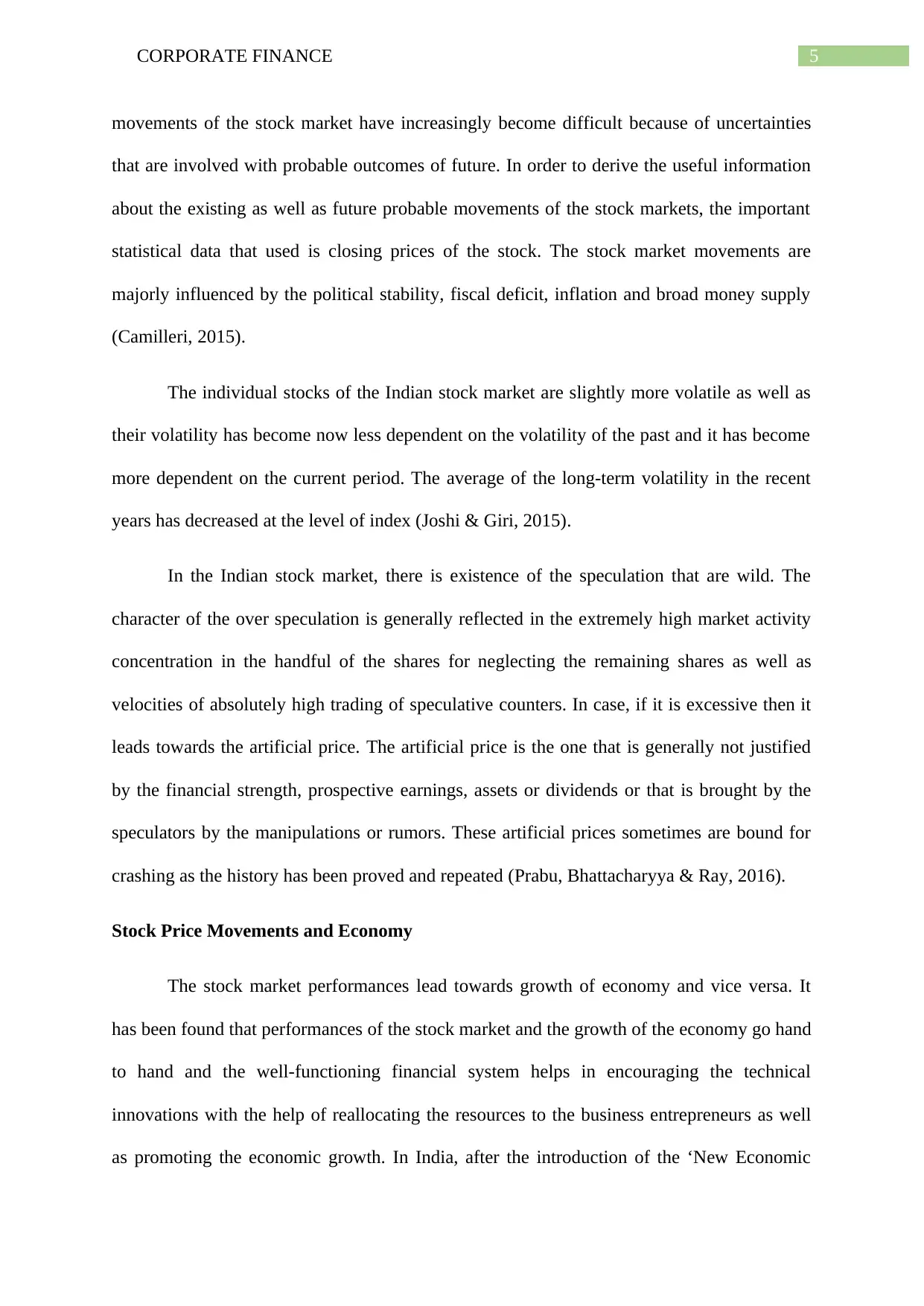
5CORPORATE FINANCE
movements of the stock market have increasingly become difficult because of uncertainties
that are involved with probable outcomes of future. In order to derive the useful information
about the existing as well as future probable movements of the stock markets, the important
statistical data that used is closing prices of the stock. The stock market movements are
majorly influenced by the political stability, fiscal deficit, inflation and broad money supply
(Camilleri, 2015).
The individual stocks of the Indian stock market are slightly more volatile as well as
their volatility has become now less dependent on the volatility of the past and it has become
more dependent on the current period. The average of the long-term volatility in the recent
years has decreased at the level of index (Joshi & Giri, 2015).
In the Indian stock market, there is existence of the speculation that are wild. The
character of the over speculation is generally reflected in the extremely high market activity
concentration in the handful of the shares for neglecting the remaining shares as well as
velocities of absolutely high trading of speculative counters. In case, if it is excessive then it
leads towards the artificial price. The artificial price is the one that is generally not justified
by the financial strength, prospective earnings, assets or dividends or that is brought by the
speculators by the manipulations or rumors. These artificial prices sometimes are bound for
crashing as the history has been proved and repeated (Prabu, Bhattacharyya & Ray, 2016).
Stock Price Movements and Economy
The stock market performances lead towards growth of economy and vice versa. It
has been found that performances of the stock market and the growth of the economy go hand
to hand and the well-functioning financial system helps in encouraging the technical
innovations with the help of reallocating the resources to the business entrepreneurs as well
as promoting the economic growth. In India, after the introduction of the ‘New Economic
movements of the stock market have increasingly become difficult because of uncertainties
that are involved with probable outcomes of future. In order to derive the useful information
about the existing as well as future probable movements of the stock markets, the important
statistical data that used is closing prices of the stock. The stock market movements are
majorly influenced by the political stability, fiscal deficit, inflation and broad money supply
(Camilleri, 2015).
The individual stocks of the Indian stock market are slightly more volatile as well as
their volatility has become now less dependent on the volatility of the past and it has become
more dependent on the current period. The average of the long-term volatility in the recent
years has decreased at the level of index (Joshi & Giri, 2015).
In the Indian stock market, there is existence of the speculation that are wild. The
character of the over speculation is generally reflected in the extremely high market activity
concentration in the handful of the shares for neglecting the remaining shares as well as
velocities of absolutely high trading of speculative counters. In case, if it is excessive then it
leads towards the artificial price. The artificial price is the one that is generally not justified
by the financial strength, prospective earnings, assets or dividends or that is brought by the
speculators by the manipulations or rumors. These artificial prices sometimes are bound for
crashing as the history has been proved and repeated (Prabu, Bhattacharyya & Ray, 2016).
Stock Price Movements and Economy
The stock market performances lead towards growth of economy and vice versa. It
has been found that performances of the stock market and the growth of the economy go hand
to hand and the well-functioning financial system helps in encouraging the technical
innovations with the help of reallocating the resources to the business entrepreneurs as well
as promoting the economic growth. In India, after the introduction of the ‘New Economic
⊘ This is a preview!⊘
Do you want full access?
Subscribe today to unlock all pages.

Trusted by 1+ million students worldwide
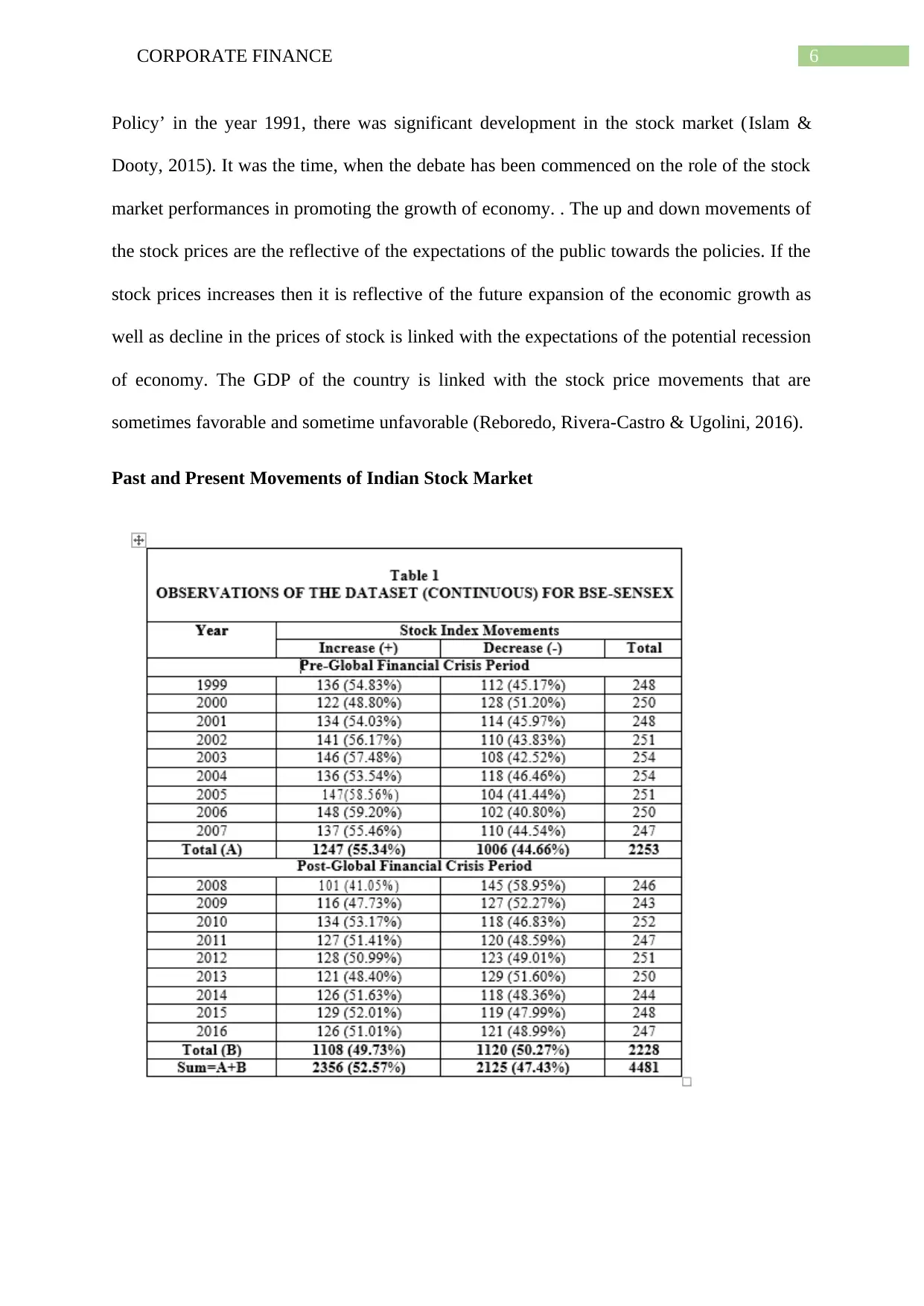
6CORPORATE FINANCE
Policy’ in the year 1991, there was significant development in the stock market (Islam &
Dooty, 2015). It was the time, when the debate has been commenced on the role of the stock
market performances in promoting the growth of economy. . The up and down movements of
the stock prices are the reflective of the expectations of the public towards the policies. If the
stock prices increases then it is reflective of the future expansion of the economic growth as
well as decline in the prices of stock is linked with the expectations of the potential recession
of economy. The GDP of the country is linked with the stock price movements that are
sometimes favorable and sometime unfavorable (Reboredo, Rivera-Castro & Ugolini, 2016).
Past and Present Movements of Indian Stock Market
Policy’ in the year 1991, there was significant development in the stock market (Islam &
Dooty, 2015). It was the time, when the debate has been commenced on the role of the stock
market performances in promoting the growth of economy. . The up and down movements of
the stock prices are the reflective of the expectations of the public towards the policies. If the
stock prices increases then it is reflective of the future expansion of the economic growth as
well as decline in the prices of stock is linked with the expectations of the potential recession
of economy. The GDP of the country is linked with the stock price movements that are
sometimes favorable and sometime unfavorable (Reboredo, Rivera-Castro & Ugolini, 2016).
Past and Present Movements of Indian Stock Market
Paraphrase This Document
Need a fresh take? Get an instant paraphrase of this document with our AI Paraphraser
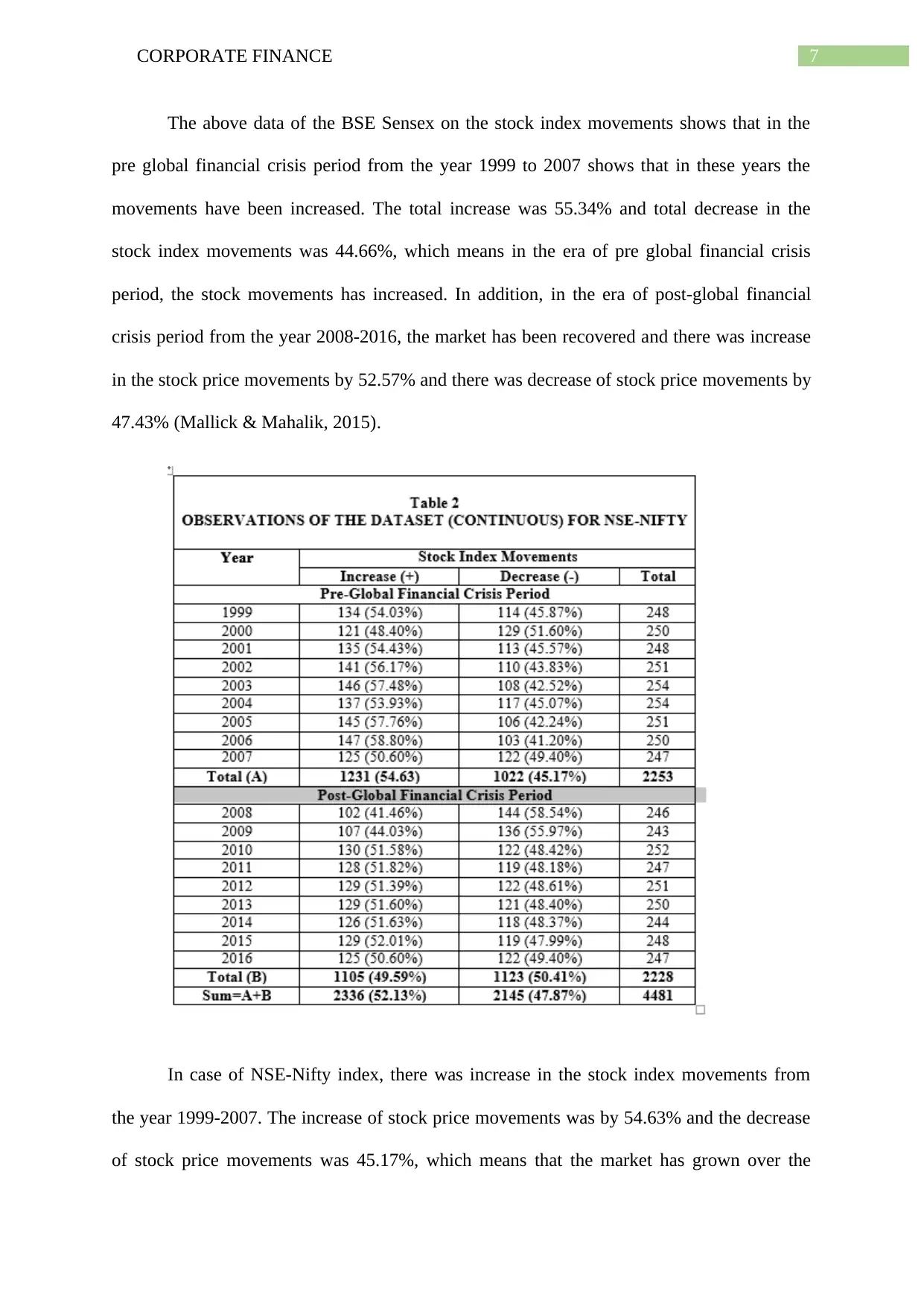
7CORPORATE FINANCE
The above data of the BSE Sensex on the stock index movements shows that in the
pre global financial crisis period from the year 1999 to 2007 shows that in these years the
movements have been increased. The total increase was 55.34% and total decrease in the
stock index movements was 44.66%, which means in the era of pre global financial crisis
period, the stock movements has increased. In addition, in the era of post-global financial
crisis period from the year 2008-2016, the market has been recovered and there was increase
in the stock price movements by 52.57% and there was decrease of stock price movements by
47.43% (Mallick & Mahalik, 2015).
In case of NSE-Nifty index, there was increase in the stock index movements from
the year 1999-2007. The increase of stock price movements was by 54.63% and the decrease
of stock price movements was 45.17%, which means that the market has grown over the
The above data of the BSE Sensex on the stock index movements shows that in the
pre global financial crisis period from the year 1999 to 2007 shows that in these years the
movements have been increased. The total increase was 55.34% and total decrease in the
stock index movements was 44.66%, which means in the era of pre global financial crisis
period, the stock movements has increased. In addition, in the era of post-global financial
crisis period from the year 2008-2016, the market has been recovered and there was increase
in the stock price movements by 52.57% and there was decrease of stock price movements by
47.43% (Mallick & Mahalik, 2015).
In case of NSE-Nifty index, there was increase in the stock index movements from
the year 1999-2007. The increase of stock price movements was by 54.63% and the decrease
of stock price movements was 45.17%, which means that the market has grown over the
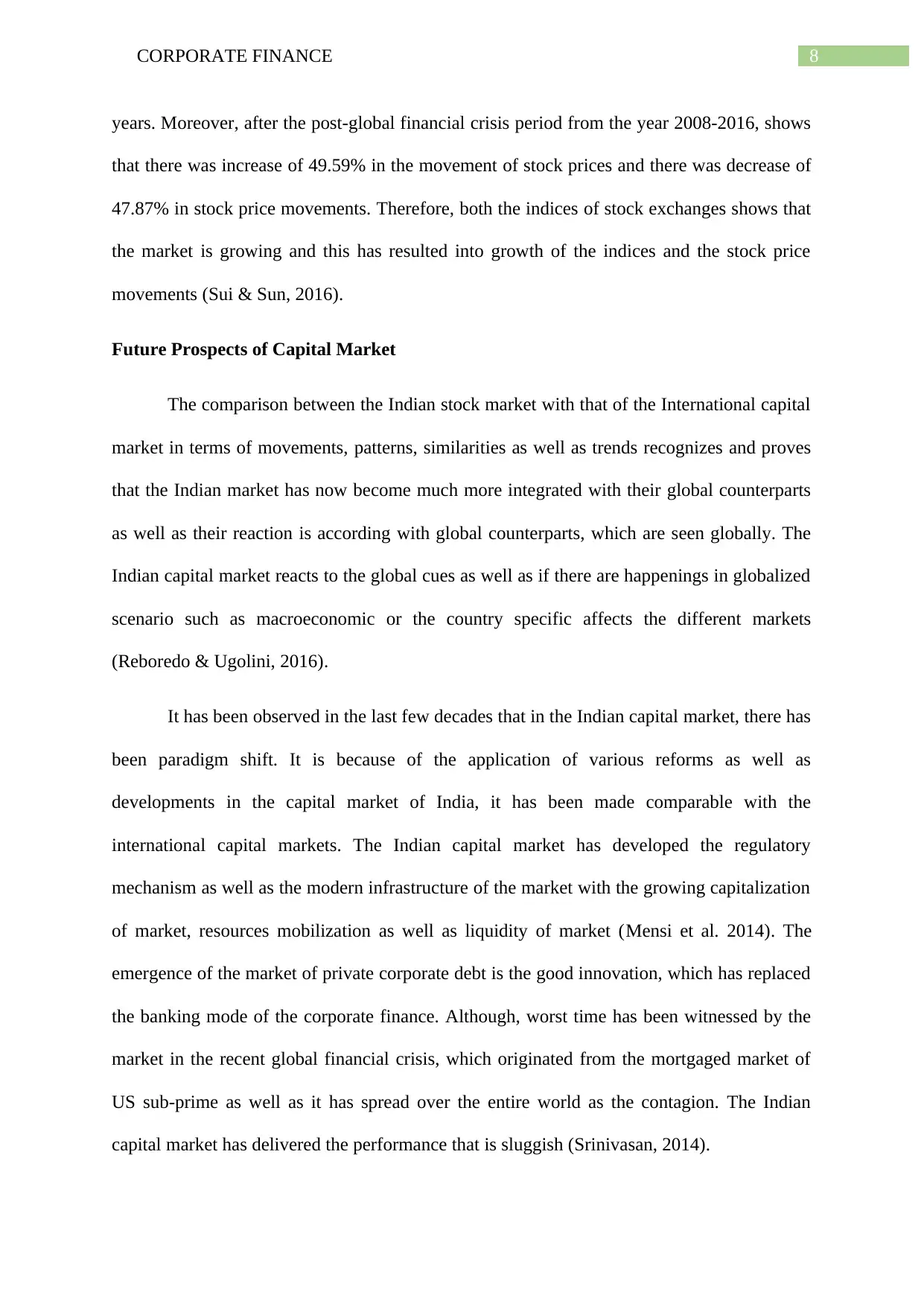
8CORPORATE FINANCE
years. Moreover, after the post-global financial crisis period from the year 2008-2016, shows
that there was increase of 49.59% in the movement of stock prices and there was decrease of
47.87% in stock price movements. Therefore, both the indices of stock exchanges shows that
the market is growing and this has resulted into growth of the indices and the stock price
movements (Sui & Sun, 2016).
Future Prospects of Capital Market
The comparison between the Indian stock market with that of the International capital
market in terms of movements, patterns, similarities as well as trends recognizes and proves
that the Indian market has now become much more integrated with their global counterparts
as well as their reaction is according with global counterparts, which are seen globally. The
Indian capital market reacts to the global cues as well as if there are happenings in globalized
scenario such as macroeconomic or the country specific affects the different markets
(Reboredo & Ugolini, 2016).
It has been observed in the last few decades that in the Indian capital market, there has
been paradigm shift. It is because of the application of various reforms as well as
developments in the capital market of India, it has been made comparable with the
international capital markets. The Indian capital market has developed the regulatory
mechanism as well as the modern infrastructure of the market with the growing capitalization
of market, resources mobilization as well as liquidity of market (Mensi et al. 2014). The
emergence of the market of private corporate debt is the good innovation, which has replaced
the banking mode of the corporate finance. Although, worst time has been witnessed by the
market in the recent global financial crisis, which originated from the mortgaged market of
US sub-prime as well as it has spread over the entire world as the contagion. The Indian
capital market has delivered the performance that is sluggish (Srinivasan, 2014).
years. Moreover, after the post-global financial crisis period from the year 2008-2016, shows
that there was increase of 49.59% in the movement of stock prices and there was decrease of
47.87% in stock price movements. Therefore, both the indices of stock exchanges shows that
the market is growing and this has resulted into growth of the indices and the stock price
movements (Sui & Sun, 2016).
Future Prospects of Capital Market
The comparison between the Indian stock market with that of the International capital
market in terms of movements, patterns, similarities as well as trends recognizes and proves
that the Indian market has now become much more integrated with their global counterparts
as well as their reaction is according with global counterparts, which are seen globally. The
Indian capital market reacts to the global cues as well as if there are happenings in globalized
scenario such as macroeconomic or the country specific affects the different markets
(Reboredo & Ugolini, 2016).
It has been observed in the last few decades that in the Indian capital market, there has
been paradigm shift. It is because of the application of various reforms as well as
developments in the capital market of India, it has been made comparable with the
international capital markets. The Indian capital market has developed the regulatory
mechanism as well as the modern infrastructure of the market with the growing capitalization
of market, resources mobilization as well as liquidity of market (Mensi et al. 2014). The
emergence of the market of private corporate debt is the good innovation, which has replaced
the banking mode of the corporate finance. Although, worst time has been witnessed by the
market in the recent global financial crisis, which originated from the mortgaged market of
US sub-prime as well as it has spread over the entire world as the contagion. The Indian
capital market has delivered the performance that is sluggish (Srinivasan, 2014).
⊘ This is a preview!⊘
Do you want full access?
Subscribe today to unlock all pages.

Trusted by 1+ million students worldwide
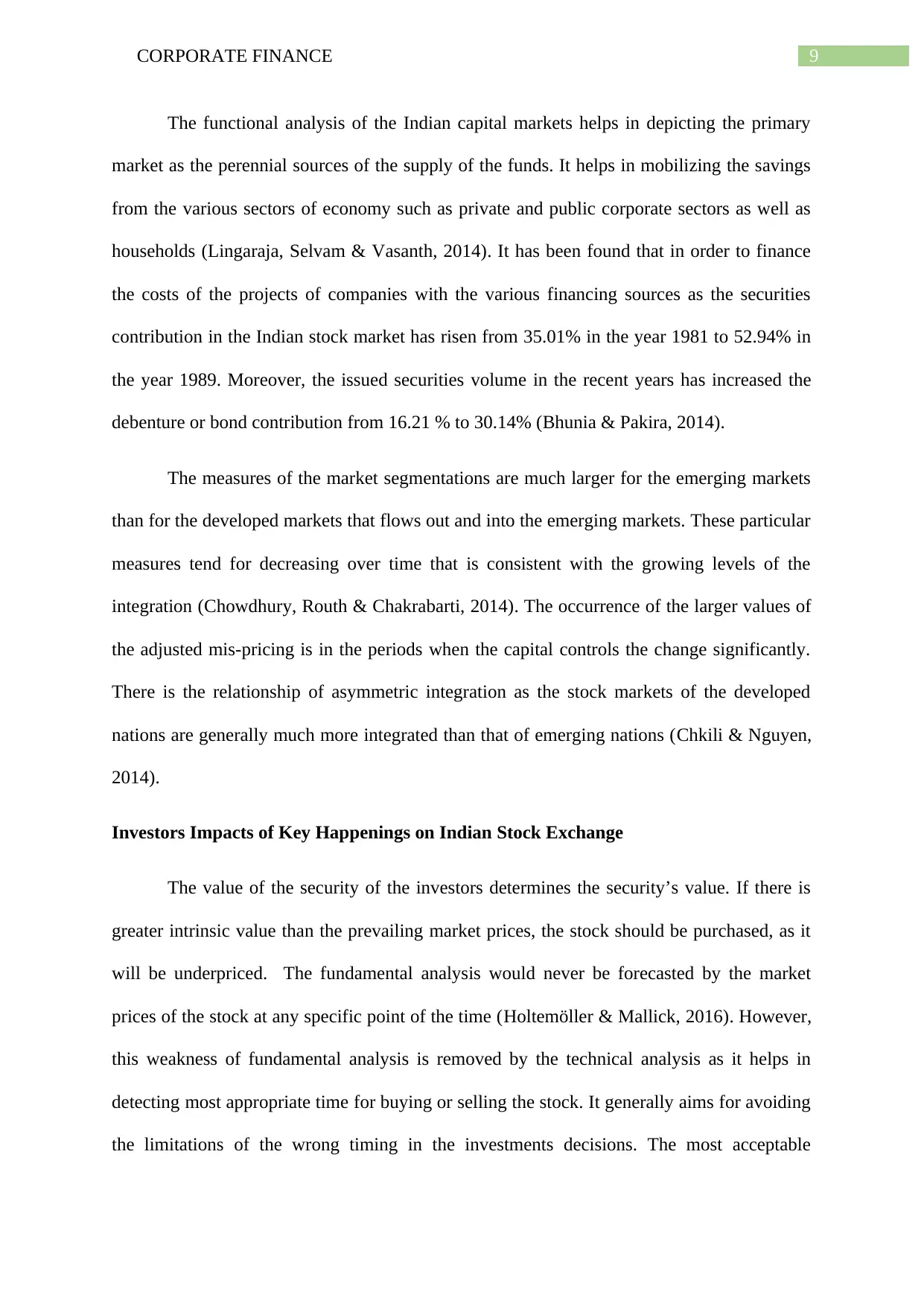
9CORPORATE FINANCE
The functional analysis of the Indian capital markets helps in depicting the primary
market as the perennial sources of the supply of the funds. It helps in mobilizing the savings
from the various sectors of economy such as private and public corporate sectors as well as
households (Lingaraja, Selvam & Vasanth, 2014). It has been found that in order to finance
the costs of the projects of companies with the various financing sources as the securities
contribution in the Indian stock market has risen from 35.01% in the year 1981 to 52.94% in
the year 1989. Moreover, the issued securities volume in the recent years has increased the
debenture or bond contribution from 16.21 % to 30.14% (Bhunia & Pakira, 2014).
The measures of the market segmentations are much larger for the emerging markets
than for the developed markets that flows out and into the emerging markets. These particular
measures tend for decreasing over time that is consistent with the growing levels of the
integration (Chowdhury, Routh & Chakrabarti, 2014). The occurrence of the larger values of
the adjusted mis-pricing is in the periods when the capital controls the change significantly.
There is the relationship of asymmetric integration as the stock markets of the developed
nations are generally much more integrated than that of emerging nations (Chkili & Nguyen,
2014).
Investors Impacts of Key Happenings on Indian Stock Exchange
The value of the security of the investors determines the security’s value. If there is
greater intrinsic value than the prevailing market prices, the stock should be purchased, as it
will be underpriced. The fundamental analysis would never be forecasted by the market
prices of the stock at any specific point of the time (Holtemöller & Mallick, 2016). However,
this weakness of fundamental analysis is removed by the technical analysis as it helps in
detecting most appropriate time for buying or selling the stock. It generally aims for avoiding
the limitations of the wrong timing in the investments decisions. The most acceptable
The functional analysis of the Indian capital markets helps in depicting the primary
market as the perennial sources of the supply of the funds. It helps in mobilizing the savings
from the various sectors of economy such as private and public corporate sectors as well as
households (Lingaraja, Selvam & Vasanth, 2014). It has been found that in order to finance
the costs of the projects of companies with the various financing sources as the securities
contribution in the Indian stock market has risen from 35.01% in the year 1981 to 52.94% in
the year 1989. Moreover, the issued securities volume in the recent years has increased the
debenture or bond contribution from 16.21 % to 30.14% (Bhunia & Pakira, 2014).
The measures of the market segmentations are much larger for the emerging markets
than for the developed markets that flows out and into the emerging markets. These particular
measures tend for decreasing over time that is consistent with the growing levels of the
integration (Chowdhury, Routh & Chakrabarti, 2014). The occurrence of the larger values of
the adjusted mis-pricing is in the periods when the capital controls the change significantly.
There is the relationship of asymmetric integration as the stock markets of the developed
nations are generally much more integrated than that of emerging nations (Chkili & Nguyen,
2014).
Investors Impacts of Key Happenings on Indian Stock Exchange
The value of the security of the investors determines the security’s value. If there is
greater intrinsic value than the prevailing market prices, the stock should be purchased, as it
will be underpriced. The fundamental analysis would never be forecasted by the market
prices of the stock at any specific point of the time (Holtemöller & Mallick, 2016). However,
this weakness of fundamental analysis is removed by the technical analysis as it helps in
detecting most appropriate time for buying or selling the stock. It generally aims for avoiding
the limitations of the wrong timing in the investments decisions. The most acceptable
Paraphrase This Document
Need a fresh take? Get an instant paraphrase of this document with our AI Paraphraser
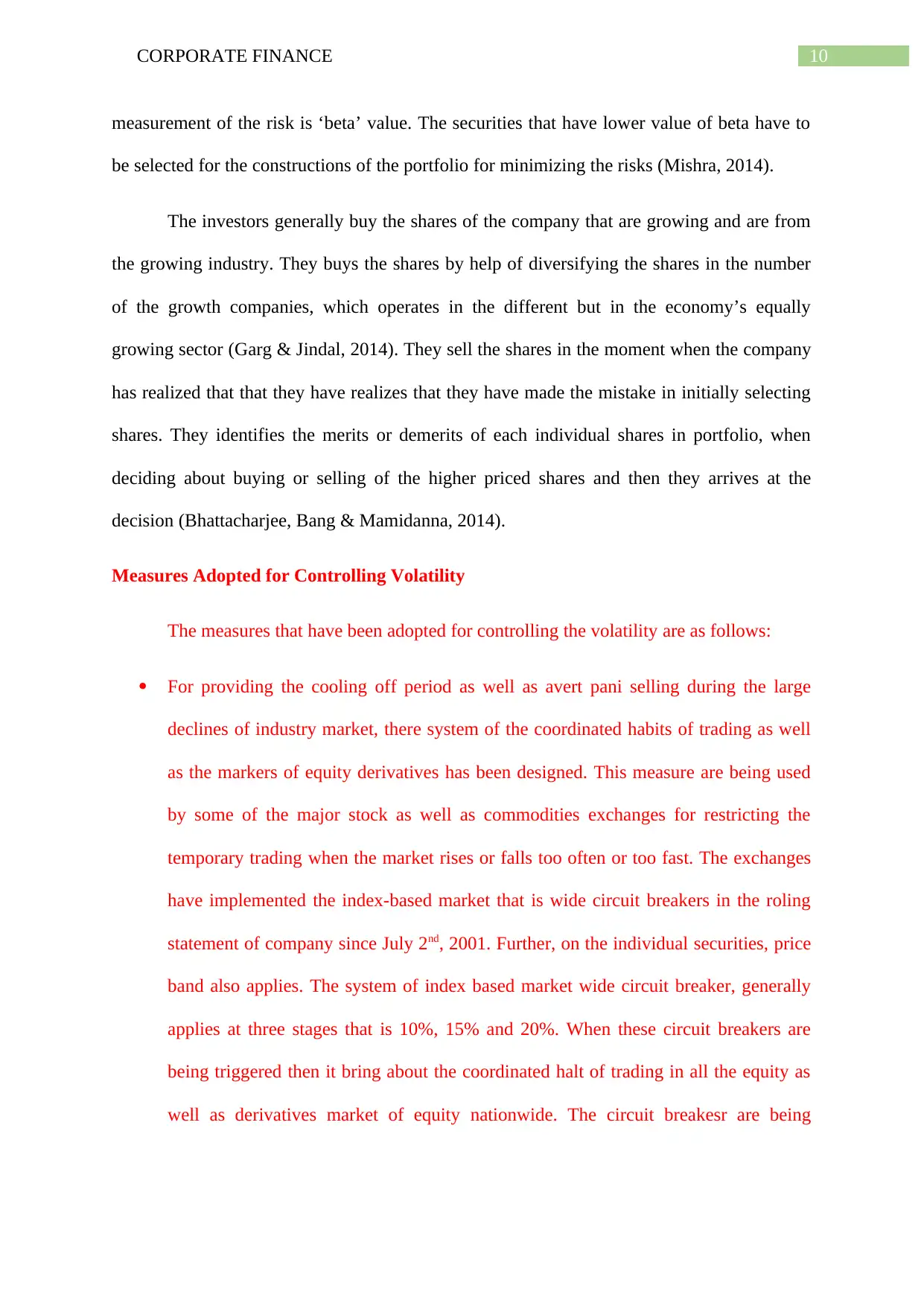
10CORPORATE FINANCE
measurement of the risk is ‘beta’ value. The securities that have lower value of beta have to
be selected for the constructions of the portfolio for minimizing the risks (Mishra, 2014).
The investors generally buy the shares of the company that are growing and are from
the growing industry. They buys the shares by help of diversifying the shares in the number
of the growth companies, which operates in the different but in the economy’s equally
growing sector (Garg & Jindal, 2014). They sell the shares in the moment when the company
has realized that that they have realizes that they have made the mistake in initially selecting
shares. They identifies the merits or demerits of each individual shares in portfolio, when
deciding about buying or selling of the higher priced shares and then they arrives at the
decision (Bhattacharjee, Bang & Mamidanna, 2014).
Measures Adopted for Controlling Volatility
The measures that have been adopted for controlling the volatility are as follows:
For providing the cooling off period as well as avert pani selling during the large
declines of industry market, there system of the coordinated habits of trading as well
as the markers of equity derivatives has been designed. This measure are being used
by some of the major stock as well as commodities exchanges for restricting the
temporary trading when the market rises or falls too often or too fast. The exchanges
have implemented the index-based market that is wide circuit breakers in the roling
statement of company since July 2nd, 2001. Further, on the individual securities, price
band also applies. The system of index based market wide circuit breaker, generally
applies at three stages that is 10%, 15% and 20%. When these circuit breakers are
being triggered then it bring about the coordinated halt of trading in all the equity as
well as derivatives market of equity nationwide. The circuit breakesr are being
measurement of the risk is ‘beta’ value. The securities that have lower value of beta have to
be selected for the constructions of the portfolio for minimizing the risks (Mishra, 2014).
The investors generally buy the shares of the company that are growing and are from
the growing industry. They buys the shares by help of diversifying the shares in the number
of the growth companies, which operates in the different but in the economy’s equally
growing sector (Garg & Jindal, 2014). They sell the shares in the moment when the company
has realized that that they have realizes that they have made the mistake in initially selecting
shares. They identifies the merits or demerits of each individual shares in portfolio, when
deciding about buying or selling of the higher priced shares and then they arrives at the
decision (Bhattacharjee, Bang & Mamidanna, 2014).
Measures Adopted for Controlling Volatility
The measures that have been adopted for controlling the volatility are as follows:
For providing the cooling off period as well as avert pani selling during the large
declines of industry market, there system of the coordinated habits of trading as well
as the markers of equity derivatives has been designed. This measure are being used
by some of the major stock as well as commodities exchanges for restricting the
temporary trading when the market rises or falls too often or too fast. The exchanges
have implemented the index-based market that is wide circuit breakers in the roling
statement of company since July 2nd, 2001. Further, on the individual securities, price
band also applies. The system of index based market wide circuit breaker, generally
applies at three stages that is 10%, 15% and 20%. When these circuit breakers are
being triggered then it bring about the coordinated halt of trading in all the equity as
well as derivatives market of equity nationwide. The circuit breakesr are being
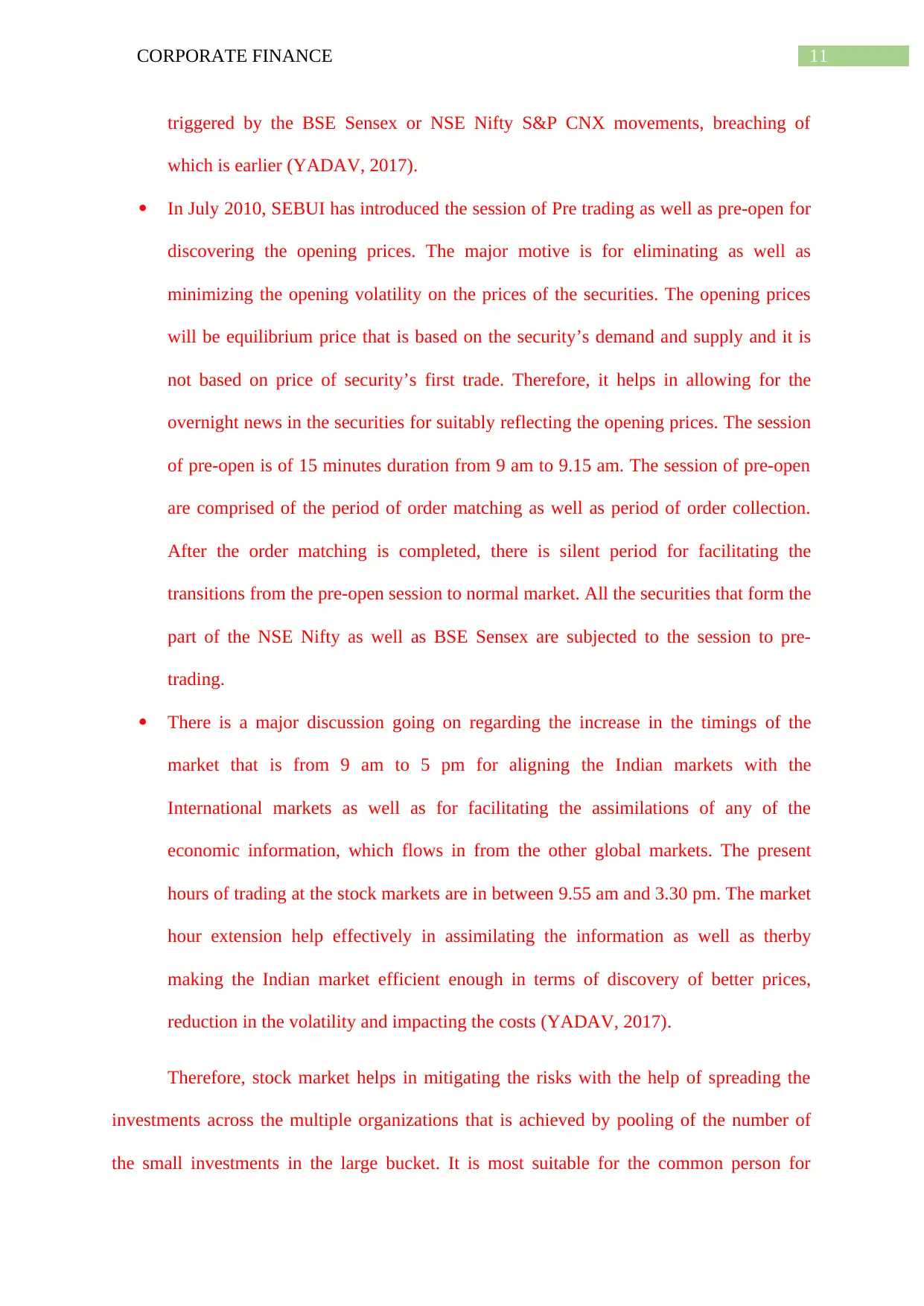
11CORPORATE FINANCE
triggered by the BSE Sensex or NSE Nifty S&P CNX movements, breaching of
which is earlier (YADAV, 2017).
In July 2010, SEBUI has introduced the session of Pre trading as well as pre-open for
discovering the opening prices. The major motive is for eliminating as well as
minimizing the opening volatility on the prices of the securities. The opening prices
will be equilibrium price that is based on the security’s demand and supply and it is
not based on price of security’s first trade. Therefore, it helps in allowing for the
overnight news in the securities for suitably reflecting the opening prices. The session
of pre-open is of 15 minutes duration from 9 am to 9.15 am. The session of pre-open
are comprised of the period of order matching as well as period of order collection.
After the order matching is completed, there is silent period for facilitating the
transitions from the pre-open session to normal market. All the securities that form the
part of the NSE Nifty as well as BSE Sensex are subjected to the session to pre-
trading.
There is a major discussion going on regarding the increase in the timings of the
market that is from 9 am to 5 pm for aligning the Indian markets with the
International markets as well as for facilitating the assimilations of any of the
economic information, which flows in from the other global markets. The present
hours of trading at the stock markets are in between 9.55 am and 3.30 pm. The market
hour extension help effectively in assimilating the information as well as therby
making the Indian market efficient enough in terms of discovery of better prices,
reduction in the volatility and impacting the costs (YADAV, 2017).
Therefore, stock market helps in mitigating the risks with the help of spreading the
investments across the multiple organizations that is achieved by pooling of the number of
the small investments in the large bucket. It is most suitable for the common person for
triggered by the BSE Sensex or NSE Nifty S&P CNX movements, breaching of
which is earlier (YADAV, 2017).
In July 2010, SEBUI has introduced the session of Pre trading as well as pre-open for
discovering the opening prices. The major motive is for eliminating as well as
minimizing the opening volatility on the prices of the securities. The opening prices
will be equilibrium price that is based on the security’s demand and supply and it is
not based on price of security’s first trade. Therefore, it helps in allowing for the
overnight news in the securities for suitably reflecting the opening prices. The session
of pre-open is of 15 minutes duration from 9 am to 9.15 am. The session of pre-open
are comprised of the period of order matching as well as period of order collection.
After the order matching is completed, there is silent period for facilitating the
transitions from the pre-open session to normal market. All the securities that form the
part of the NSE Nifty as well as BSE Sensex are subjected to the session to pre-
trading.
There is a major discussion going on regarding the increase in the timings of the
market that is from 9 am to 5 pm for aligning the Indian markets with the
International markets as well as for facilitating the assimilations of any of the
economic information, which flows in from the other global markets. The present
hours of trading at the stock markets are in between 9.55 am and 3.30 pm. The market
hour extension help effectively in assimilating the information as well as therby
making the Indian market efficient enough in terms of discovery of better prices,
reduction in the volatility and impacting the costs (YADAV, 2017).
Therefore, stock market helps in mitigating the risks with the help of spreading the
investments across the multiple organizations that is achieved by pooling of the number of
the small investments in the large bucket. It is most suitable for the common person for
⊘ This is a preview!⊘
Do you want full access?
Subscribe today to unlock all pages.

Trusted by 1+ million students worldwide
1 out of 17
Related Documents
Your All-in-One AI-Powered Toolkit for Academic Success.
+13062052269
info@desklib.com
Available 24*7 on WhatsApp / Email
![[object Object]](/_next/static/media/star-bottom.7253800d.svg)
Unlock your academic potential
Copyright © 2020–2025 A2Z Services. All Rights Reserved. Developed and managed by ZUCOL.





